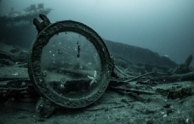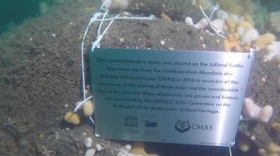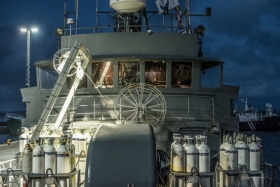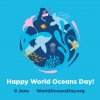CMAS Dive for Peace Expedition Jutland 2016
Science confederation 22.09.2016
CMAS (the World Federation of Underwater Activities) organized an international exploration expedition ‘CMAS Dive for Peace’ in the North Sea from 21th of August until 6th of September 2016. The Expedition under the wing of the UNESCO was centered on the research of the wreckage of warships sunk during the Battle of Jutland in 1916 (the largest naval battle in history). 60 divers from 15 different nationalities participated in the technical exploration, scientific and medical aspects of the project.
The Jutland sea war Museum in Thyborøn and the Expedition ship Cdt. Fourcault were the epicenters of the expedition. Presentations were given by the president of CMAS Anna Arzhanova, as well as representatives of UNESCO, expert historians and local politicians. These presentations were assisted by the participating divers, the CMAS General Secretary, the CMAS Treasurer, the CMAS scientific president, the CMAS TC president, the CMAS Dive for Peace Expedition leader Stef Teuwen and presidents of CMAS federations from France and Denmark.
The Battle of Jutland raged for 36 hours from 31th May to 1th June 1916. The battle, which is still the largest naval battle of all times, involved a total of 152 British and German warships and nearly 100 000 people. In the short battle about 9 000 people died. The expedition which took place on the centenary of the battle served a dual purpose, data-collection about the state of the wrecks and as a solemn memorial to the people who lost their lives there. One of the main purposes of the expedition was to determine the current conditions of the wrecks vs. dives conducted in 2009 and 2014.  During two weeks seven of the most emblematic wrecks were explored, photographed and filmed of the twenty-five sunken warships, by the divers of the expedition (32 divers in the first week and 28 divers on the last week), which means – all things considered – more than 200 hours of underwater research was completed per wreck (and almost 400 hours in case of the H.M.S. DEFENCE, which is one of the most spectacular wrecks). Considerable amount of photographs and film footage were collected during this period (more than 5 000 photographs plus many hours of video recording).
During two weeks seven of the most emblematic wrecks were explored, photographed and filmed of the twenty-five sunken warships, by the divers of the expedition (32 divers in the first week and 28 divers on the last week), which means – all things considered – more than 200 hours of underwater research was completed per wreck (and almost 400 hours in case of the H.M.S. DEFENCE, which is one of the most spectacular wrecks). Considerable amount of photographs and film footage were collected during this period (more than 5 000 photographs plus many hours of video recording).
Members of the research team came from 15 countries. Technical divers – with thousands of diving hours behind them – professionally carried out the task of gathering all the information which was necessary to identify and confirm the current condition of the shipwrecks and to aid in the reconstruction of the sinking process of all the wrecked ships. Most of the ships sank as a result of onboard ammunition explosions which occurred after direct hits by the enemy. For this reason, some wrecks did not show a familiar ship form: some literally became smoke and evaporated after the powerful explosions. An example of this case is the British battlecruiser H.M.S. QUEEN MARY, in which more than 1200 people died and only 9 survivors been picked up out of the whole crew (a number equal to that of a small town's population). The sinking only lasted nine minutes, and today only smaller pieces of the ship can be identified scattered around the wreck site.
Most of the ships sank as a result of onboard ammunition explosions which occurred after direct hits by the enemy. For this reason, some wrecks did not show a familiar ship form: some literally became smoke and evaporated after the powerful explosions. An example of this case is the British battlecruiser H.M.S. QUEEN MARY, in which more than 1200 people died and only 9 survivors been picked up out of the whole crew (a number equal to that of a small town's population). The sinking only lasted nine minutes, and today only smaller pieces of the ship can be identified scattered around the wreck site.
 After a hundred years on the bottom of the North Sea, the condition of the wrecks has been adversely affected by four main factors: 1) natural deterioration (degradation influenced by the loss of strength caused by corrosion and the currents on the shallow seabed amplified by powerful waves); 2) illegal industrial salvage (for non-rusting and other precious metals), 3) trawler fishing, 4) Technical diving – In case of unauthorized rising of objects from the wreck-site.
After a hundred years on the bottom of the North Sea, the condition of the wrecks has been adversely affected by four main factors: 1) natural deterioration (degradation influenced by the loss of strength caused by corrosion and the currents on the shallow seabed amplified by powerful waves); 2) illegal industrial salvage (for non-rusting and other precious metals), 3) trawler fishing, 4) Technical diving – In case of unauthorized rising of objects from the wreck-site.
The results of the expedition may contribute to establishment of regular observation of the wrecks which can confirm the need of the cultural salvaging if necessary by evaluation on the extent, the causes and progress of disintegration of the wrecks. CMAS leadership welcomed the proposal for the deployment of a related wreck-monitoring system. This is important, because the UNESCO convention on the protection of underwater cultural heritage can permit these actions after the shipwrecks have completely collapsed. This date may apparently be reached sooner rather than later in case of Jutland wrecks. The Sea War Museum, an outstanding showroom of the history of the Battle of Jutland – which is located in Thyborøn, Denmark, the nearest port to the Jutland wreck-site, is able to meet the challenges associated with the conservation and management of recovered underwater cultural heritage.
 Another aspect of the expedition was the presence on board of a special medical team (with expertise in diving medicine and cardio ultrasound). The team performed research and collected data about bubbles in the circulatory system and in particular in the heart using real time echocardiogram recordings. Using the participating technical divers as subjects (after long decompression cold water dives), they investigated the presence of bubbles in the left side of the heart from the first 10 minutes after surfacing up until 1.5 hours after. Interestingly some divers showed no bubbles while others showed a lot of bubbles for the same dive/decompression profile. Results of this investigation will be published in the future.
Another aspect of the expedition was the presence on board of a special medical team (with expertise in diving medicine and cardio ultrasound). The team performed research and collected data about bubbles in the circulatory system and in particular in the heart using real time echocardiogram recordings. Using the participating technical divers as subjects (after long decompression cold water dives), they investigated the presence of bubbles in the left side of the heart from the first 10 minutes after surfacing up until 1.5 hours after. Interestingly some divers showed no bubbles while others showed a lot of bubbles for the same dive/decompression profile. Results of this investigation will be published in the future.
Two dives were conducted each day with a bottom time from 40-80 minutes at 50 to 60m, followed by the required amount of decompression time (average run times ranging from 100 to 180 minutes). Divers visited the wrecks H.M.S. QUEEN MARY (0,5-1 m visibility) H.M.S. INDEFATIGABLE (10m visibility), H.M.S. DEFENCE (10-15m visibility) and H.M.S. INVINCIBLE (10m visibility). The preparatory works of the expedition were led by the Belgian CMAS technical diver and instructor Stef Teuwen, with the support of the CMAS, started in April 2015. That is, the entire preparation took more than one and a half years. This long preliminary work finally culminated in the successful two-week series of dives. Stef as expedition leader supervised all diving and safety procedures during the expedition. The evaluation of the results is just beginning.
The preparatory works of the expedition were led by the Belgian CMAS technical diver and instructor Stef Teuwen, with the support of the CMAS, started in April 2015. That is, the entire preparation took more than one and a half years. This long preliminary work finally culminated in the successful two-week series of dives. Stef as expedition leader supervised all diving and safety procedures during the expedition. The evaluation of the results is just beginning.
10th September 2016.
Dr. Balogh Tamás
Related pictures & videos
 science
02.11.2016
Jutland Battle Anniversary 2016 - Commemorative Stone by CMAS
science
02.11.2016
Jutland Battle Anniversary 2016 - Commemorative Stone by CMAS
 science
02.11.2016
Jutland Battle Anniversary 2016. - Commemorative Stone by CMAS
science
02.11.2016
Jutland Battle Anniversary 2016. - Commemorative Stone by CMAS
 science
22.09.2016
CMAS Dive for Peace Expedition Jutland 2016
science
22.09.2016
CMAS Dive for Peace Expedition Jutland 2016



























